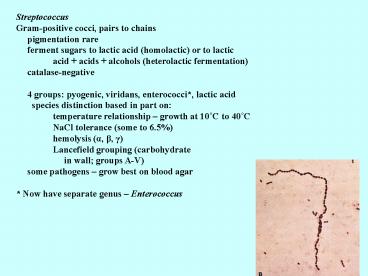Streptococcus - PowerPoint PPT Presentation
1 / 20
Title: Streptococcus
1
Streptococcus Gram-positive cocci, pairs to
chains pigmentation rare ferment sugars
to lactic acid (homolactic) or to lactic acid
acids alcohols (heterolactic fermentation)
catalase-negative 4 groups pyogenic,
viridans, enterococci, lactic acid
species distinction based in part
on temperature relationship growth at 10C to
40C NaCl tolerance (some to 6.5) hemolysis
(a, ß, ?) Lancefield grouping (carbohydrate
in wall groups A-V) some pathogens grow
best on blood agar Now have separate genus
Enterococcus
2
Group A - pyogenic S. pyogenes acute
infections Group B - major sepsis in newborns
S. agalactiae post-partum infections in
women Viridans - normal oral flora, dental
caries no group antigen shown have capsular
antigen Pneumococcus - S. pneumoniae no
Lancefield antigen capsular antigen acute lung
inflammation acute bacterial meningitis (age 15
older) Group D Enterococcus bowel flora,
opportunists E. faecalis
3
Virulence factors M protein in Group A
antiphagocytic factor surface protein cells
fuzzy binds to factor H causing rapid
destruction of complement C3b prevents
opsonization C5a peptidase in Group
A C5a attracts phagocytes activates
them protease destroys C5a F protein in
Group A pneumococcus binds fibronectin on host
cells adherence factor strep
throat helps bacteria evade immune system
4
Virulence factors capsules S. pneumoniae
complex polysaccharide (sugar alcohols, amino
sugars, sugars and choline choline
important) antiphagocytic cells not
engulfed hyaluronic acid, associated with
rheumatic fever role unclear associated
with rheumatic fever dextran in oral bacteria
S. salivarius, S. mutans lipoteichoic acid
attachment to epithelium IgA protease - S.
pneumoniae avoid entrapment in mucus?
5
Virulence factors Pneumolysin - binds
cholesterol pore in cell membrane released on
cell death causes inflammation, the cause of
symptoms/signs of strep infections
Erythrogenic toxin pyrogenic Exotoxin A (Spe A)
causes TSS-like syndrome TSLS
superantigen Exfoliatin - triggers
inflammatory response tissue damage, T cell
proliferation
6
Virulence factors hemolysins Streptolysin
O (SLO) Streptolysin S (SLS) SLO pore
former in erythrocytes maybe heart tissue
enhanced by erythrogenic toxin (Spe A) may be
the cause of rheumatic heart damage
7
Streptococcal diseases Pneumonia - cells
colonize pharynx - cells by-pass clearance
mechanisms get to lung - cells escape
phagocytosis - cells induce inflammation -
cells damage endothelial cells causing septicemia
8
Streptococcal diseases pneumonia
inflammatory response - cell components activate
alternate complement pathway cell components
stimulate IL-1 and TNF-a release cell
components stimulate antibody production -
antibody attaches to cell wall, triggers
complement cascade (C5a) macrophages
neutrophils drawn in cant take up cells as
receptors are under capsule - blood vessels
become leaky to let neutrophils out -
pneumolysin also activates complement
pneumolysin binds Fc
9
Streptococcal diseases pneumonia
inflammatory response - bacteria pass to blood
stream, attach to blood vessels in
brain spinal cord - damage to blood vessels
occurs due to complement and other
chemicals (e.g., IL-1 and TNF-a) - meningitis
may result as bacteria enter cerebrospinal
fluid meningitis may arise as described
above may arise from middle ear infections
10
(No Transcript)
11
Streptococcal diseases strep
throat bacteria adhere to throat F protein
binds fibronectin lipoteichoic acid in
cell wall inflammatory response bacterial
enzymes cause tissue damage hemolysin,
proteases, streptokinase cell wall
components trigger complement cascade
cytokine release mucopeptide, teichoic
acids scarlet fever - strep throat plus rash
12
Streptococcal diseases Sequelae to strep
throat rheumatic fever glomerulonephritis
bacteria in throat lyse due to inflammatory
response wall fragments trigger antibody
response RF antibodies to M protein,
SLO, etc. cross react with proteins on
cardiac muscle T lymphocytes attack,
inflammatory response occurs heart valves
damaged Glomerulonephritis antibodies
complex with bacterial components in
blood AG-Ab complexes accumulate in
kidney inflammatory response damages kidney
13
Streptococcal diseases
14
Streptococcal diseases
15
Streptococcal diseases Toxic Shock-like
Syndrome S. pyogenes often seen in
individuals with underlying problems high
fatality rate Streptococcal pyrogenic
exotoxin (SPE) similar to TSST-1 of S.
aureus toxin also produced by strains assoc with
scarlet fever fever, shock, multiple organ
failure
16
Streptococcal diseases necrotizing
fasciitis infections mixed S. pyogenes most
serious high mortality extensive tissue damage,
necrosis with purulent exudate skin,
fascia, and muscles affected septicemia
likely
17
Streptococcal diseases necrotizing
fasciitis
18
Streptococcal diseases impetigo thick,
adherent lesions with dirty yellow crust highly
contagious
19
Streptococcal diseases erysipelas and
cellulitis skin is erythematous, edematous
and tender
Cellulitis Erysipelas
20
Streptococcal diseases Impetigo three
types common form S. pyogenes or S. aureus?

